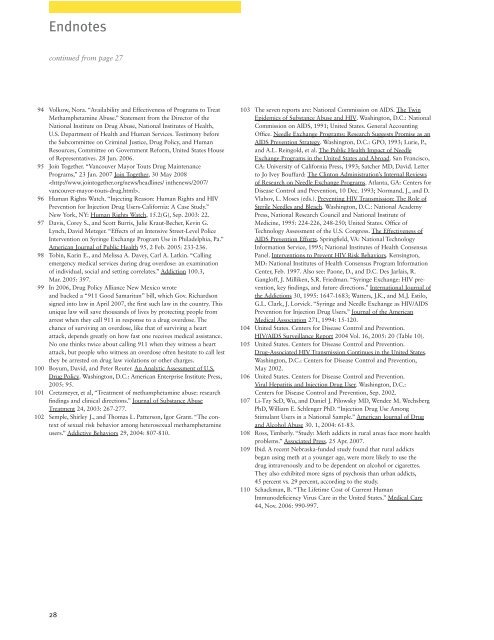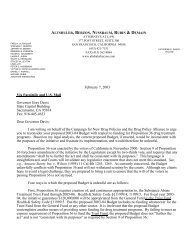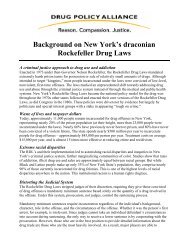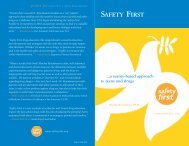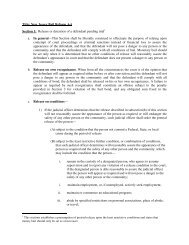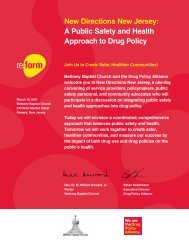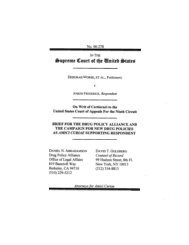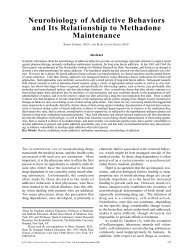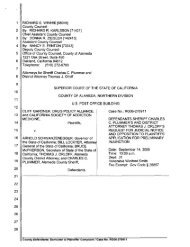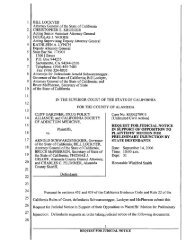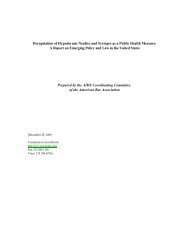A Four Pillars Approach to Methamphetamine - Drug Policy Alliance
A Four Pillars Approach to Methamphetamine - Drug Policy Alliance
A Four Pillars Approach to Methamphetamine - Drug Policy Alliance
Create successful ePaper yourself
Turn your PDF publications into a flip-book with our unique Google optimized e-Paper software.
Endnotes<br />
continued from page 27<br />
94 Volkow, Nora. “Availability and Effectiveness of Programs <strong>to</strong> Treat<br />
<strong>Methamphetamine</strong> Abuse.” Statement from the Direc<strong>to</strong>r of the<br />
National Institute on <strong>Drug</strong> Abuse, National Institutes of Health,<br />
U.S. Department of Health and Human Services. Testimony before<br />
the Subcommittee on Criminal Justice, <strong>Drug</strong> <strong>Policy</strong>, and Human<br />
Resources, Committee on Government Reform, United States House<br />
of Representatives. 28 Jun. 2006.<br />
95 Join Together. “Vancouver Mayor Touts <strong>Drug</strong> Maintenance<br />
Programs,” 23 Jan. 2007 Join Together, 30 May 2008<br />
.<br />
96 Human Rights Watch. “Injecting Reason: Human Rights and HIV<br />
Prevention for Injection <strong>Drug</strong> Users-California: A Case Study.”<br />
New York, NY: Human Rights Watch, 15.2(G), Sep. 2003: 22.<br />
97 Davis, Corey S., and Scott Burris, Julie Kraut-Becher, Kevin G.<br />
Lynch, David Metzger. “Effects of an Intensive Street-Level Police<br />
Intervention on Syringe Exchange Program Use in Philadelphia, Pa.”<br />
American Journal of Public Health 95, 2 Feb. 2005: 233-236.<br />
98 Tobin, Karin E., and Melissa A. Davey, Carl A. Latkin. “Calling<br />
emergency medical services during drug overdose: an examination<br />
of individual, social and setting correlates.” Addiction 100.3,<br />
Mar. 2005: 397.<br />
99 In 2006, <strong>Drug</strong> <strong>Policy</strong> <strong>Alliance</strong> New Mexico wrote<br />
and backed a “911 Good Samaritan” bill, which Gov. Richardson<br />
signed in<strong>to</strong> law in April 2007, the first such law in the country. This<br />
unique law will save thousands of lives by protecting people from<br />
arrest when they call 911 in response <strong>to</strong> a drug overdose. The<br />
chance of surviving an overdose, like that of surviving a heart<br />
attack, depends greatly on how fast one receives medical assistance.<br />
No one thinks twice about calling 911 when they witness a heart<br />
attack, but people who witness an overdose often hesitate <strong>to</strong> call lest<br />
they be arrested on drug law violations or other charges.<br />
100 Boyum, David, and Peter Reuter. An Analytic Assessment of U.S.<br />
<strong>Drug</strong> <strong>Policy</strong>. Washing<strong>to</strong>n, D.C.: American Enterprise Institute Press,<br />
2005: 95.<br />
101 Cretzmeyer, et al, “Treatment of methamphetamine abuse: research<br />
findings and clinical directions.” Journal of Substance Abuse<br />
Treatment 24, 2003: 267-277.<br />
102 Semple, Shirley J., and Thomas L. Patterson, Igor Grant. “The context<br />
of sexual risk behavior among heterosexual methamphetamine<br />
users.” Addictive Behaviors 29, 2004: 807-810.<br />
103 The seven reports are: National Commission on AIDS. The Twin<br />
Epidemics of Substance Abuse and HIV. Washing<strong>to</strong>n, D.C.: National<br />
Commission on AIDS, 1991; United States. General Accounting<br />
Office. Needle Exchange Programs: Research Suggests Promise as an<br />
AIDS Prevention Strategy. Washing<strong>to</strong>n, D.C.: GPO, 1993; Lurie, P.,<br />
and A.L. Reingold, et al. The Public Health Impact of Needle<br />
Exchange Programs in the United States and Abroad. San Francisco,<br />
CA: University of California Press, 1993; Satcher MD, David. Letter<br />
<strong>to</strong> Jo Ivey Bouffard: The Clin<strong>to</strong>n Administration’s Internal Reviews<br />
of Research on Needle Exchange Programs. Atlanta, GA: Centers for<br />
Disease Control and Prevention, 10 Dec. 1993; Normand, J., and D.<br />
Vlahov, L. Moses (eds.). Preventing HIV Transmission: The Role of<br />
Sterile Needles and Bleach. Washing<strong>to</strong>n, D.C.: National Academy<br />
Press, National Research Council and National Institute of<br />
Medicine, 1995: 224-226, 248-250; United States. Office of<br />
Technology Assessment of the U.S. Congress. The Effectiveness of<br />
AIDS Prevention Efforts. Springfield, VA: National Technology<br />
Information Service, 1995; National Institutes of Health Consensus<br />
Panel. Interventions <strong>to</strong> Prevent HIV Risk Behaviors. Kensing<strong>to</strong>n,<br />
MD: National Institutes of Health Consensus Program Information<br />
Center, Feb. 1997. Also see: Paone, D., and D.C. Des Jarlais, R.<br />
Gangloff, J. Milliken, S.R. Friedman. “Syringe Exchange: HIV prevention,<br />
key findings, and future directions.” International Journal of<br />
the Addictions 30, 1995: 1647-1683; Watters, J.K., and M.J. Estilo,<br />
G.L. Clark, J. Lorvick. “Syringe and Needle Exchange as HIV/AIDS<br />
Prevention for Injection <strong>Drug</strong> Users.” Journal of the American<br />
Medical Association 271, 1994: 15-120.<br />
104 United States. Centers for Disease Control and Prevention.<br />
HIV/AIDS Surveillance Report 2004 Vol. 16, 2005: 20 (Table 10).<br />
105 United States. Centers for Disease Control and Prevention.<br />
<strong>Drug</strong>-Associated HIV Transmission Continues in the United States.<br />
Washing<strong>to</strong>n, D.C.: Centers for Disease Control and Prevention,<br />
May 2002.<br />
106 United States. Centers for Disease Control and Prevention.<br />
Viral Hepatitis and Injection <strong>Drug</strong> User. Washing<strong>to</strong>n, D.C.:<br />
Centers for Disease Control and Prevention, Sep. 2002.<br />
107 Li-Tzy ScD, Wu, and Daniel J. Pilowsky MD, Wendee M. Wechsberg<br />
PhD, William E. Schlenger PhD. “Injection <strong>Drug</strong> Use Among<br />
Stimulant Users in a National Sample.” American Journal of <strong>Drug</strong><br />
and Alcohol Abuse 30. 1, 2004: 61-83.<br />
108 Ross, Timberly. “Study: Meth addicts in rural areas face more health<br />
problems.” Associated Press. 25 Apr. 2007.<br />
109 Ibid. A recent Nebraska-funded study found that rural addicts<br />
began using meth at a younger age, were more likely <strong>to</strong> use the<br />
drug intravenously and <strong>to</strong> be dependent on alcohol or cigarettes.<br />
They also exhibited more signs of psychosis than urban addicts,<br />
45 percent vs. 29 percent, according <strong>to</strong> the study.<br />
110 Schackman, B. “The Lifetime Cost of Current Human<br />
Immunodeficiency Virus Care in the United States.” Medical Care<br />
44, Nov. 2006: 990-997.<br />
28


